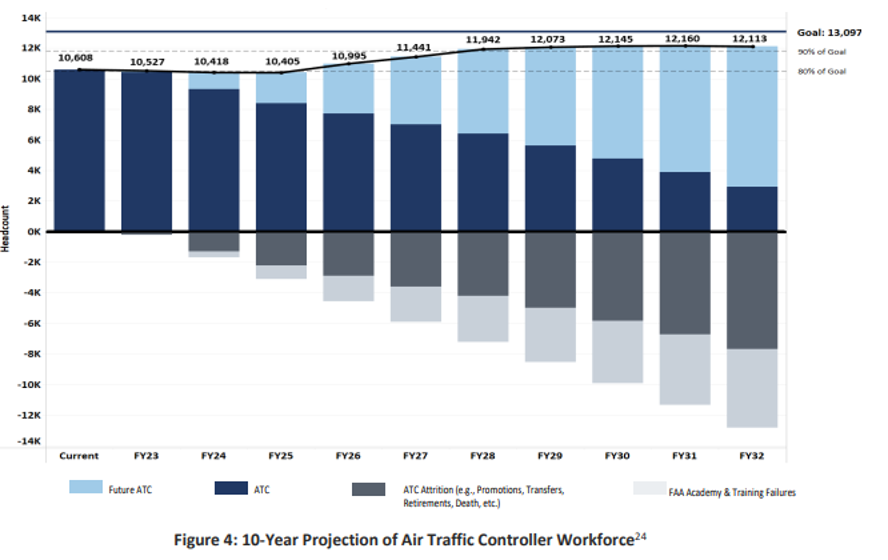Air Traffic Control is drifting into a systemic crisis

by Marc Baumgartner
IFATCA SESAR / EASA CoordinatorThe Oxford English Dictionary has published references going back to 1718 for “perfect storm”. Wikipedia describes a perfect storm as a meteorological event aggravated by a rare combination of circumstances.
Current numbers of Air Traffic Controllers around the globe have the potential of a perfect storm from a staffing point of view. IFATCA has created a heat map (IFATCA 2023) with a subjective assessment of the shortage of Air Traffic Controllers and has alerted (Deleau 2023) the European institutions that a staffing crisis is looming on the horizon.
In Europe, en-route air traffic flow management delays in 2024 reached their highest level in decades, averaging 2.13 minutes per flight. The delays were driven by a limited number of capacity-constrained Area Control Centres and an increase in weather-related disruptions—a trend that could worsen in 2025. (Performance Review Report 2024 PRR2024 ).
In the USA, according to the NAS Safety Review Team report (National Airspace System Safety Team Review, November 2023) a significant number of ATCOs are currently missing in the FAA Air Traffic Organisation. The need to hire more ATCOs is illustrated in this report.

Can the shortage of ATCOs be managed efficiently?
Demographics in the current workforce and an increase in traffic contribute to really challenging situation both in Europe and the USA. Other factors, like working contracts or retirement age add an additional layer of complication to the equation. Several mitigations to the current situation are explored.
- Cross border operations
Significant changes to current operations could be achieved by using cross border operations, without necessarily moving staff from one ATC unit to another. A long-term measure with significant planning and re-organisation could alleviate some of the current bottlenecks. This would, however, require states to rethink the way Air Traffic is organised in their country.
- Mobility of ATCOs
Mobility of ATCOs (Eurocontrol 2022) has been assessed as a possibility. Intra-centre and intra-EU mobility are possible, but due to the regulatory requirements and the complexity of “detraining” and “retraining”, the ATCOS are limited only to a short-term measure.
- Overtime
Is being used by many Air Navigation Service Providers (ANSP) in mandatory or voluntary forms to overcome the current situation, but it is limited. Although this might alleviate a shortage of capacity for a certain limited amount of time, it is not an infinite measure and all the States are challenged to train more Air Traffic Controllers.
- Increasing retirement age
Retirement for ATCOs varies throughout the world and different changes in national pension age, or age discrimination laws, have led some of the states to increase the pension age for ATCOs. A recent study (Baumgartner et al. , 2024) co-financed by the Swiss Member Association of IFATCA, Helvetica and Skyguide (Swiss ANSP), motivated by the government increase of the pension age of ATCOs from 56 to 60, has come to the conclusion that a psycho-cognitive decline due to age can be measured and poses significant challenges to be managed.
The economical costs of the shortage
The Eurocontrol Performance Review Commission calculates the cost for en-route delays in the ECAC Area (22,4 million minutes) to . The shortage of ATCOs has been estimated at 800 Million Euros for users in 2022 ( EUROCONTROL Think Paper #19 – ATC Mobility and Capacity Shortfalls | EUROCONTROL )
Under the Single European Sky Performance Scheme, States have to indicate the reason for delays when imposing delays on users. According to the PRR 2024, 38,8% of delays were due to missing capacity and 13.8% due to staff shortage. Structurally speaking, the missing ATC Capacity can be associated to a missing number of ATCO to staff the ideal number of sectors, but it is not only dependant on the number of ATCOs, but also a lack of frequencies, hardware and software limiting the number of sectors that can be opened.
Missing capacity is not evenly spread throughout Europe and the US: some ATC units are sufficiently staffed or have spare capacity due to changing traffic patterns. In Europe, for the base-line scenario, of traffic growth 700-800 ATCOs are currently missing in the core area. At an estimated cost of 600K€, the investment in sufficient ATCOs for the overall system would cost approximately €50-200 Million as a one-off investment compared to the yearly €800M the missing capacity costs the airlines.
Other components of the perfect storm are the geo-political situation blocking large chunks of airspace in the Eastern part of Europe and the Middle East. This has had some dramatic impact on the management of the traffic flows. In Europe, the SES performance schemes limit long-term investments and put pressure on the cost basis, including hiring and training new ATCOs despite the identified shortages.
In the US, one of the reasons listed for the understaffed FAA ATO system over the years is illustrated by several events which significantly impacted the successful hiring, training and certification of ATCOs. Sequestrations and government shutdowns as well as COVID further reduced the number of staff in the operations. And more recently, the Trump administration also announced incentives to reduce the number of federal employees, including those of the FAA.
The expansion plans of some of the airlines (Ryanair ordered 300 aircraft, as well as Turkish Airlines, which are to be delivered into the system in less than a decade) are not incorporated into the equation.
Is there a way out?
If air traffic continues to increase as it did in 2024, no real solution is available in the short term. The aviation sector will have to make a combined effort to attract the next generation of aviation professionals. Lesser numbers of talent are available and the selection as well as the training successes have not changed in the last 20 years. In Europe, to train one successful ATCO you need 400 young people entering the selection process. Compared to Pilot Training the ATM sector is unable to bring the ATCO to an operational maturity in a simulator environment. The duration of training an ATCO is on average 30-43 months, both in the US and Europe. Maybe simulator manufacturers should encourage greater investment into ATM simulators. New Large Language Model could maybe help to better simulate the operational reality in a simulator environment.
Certainly, for Europe the European Commission could de-couple the recruitment and training costs from the cost-efficiency target of the regulated entities in order to give some economical breathing space to train enough controllers, just to manage the demographic challenges that are looming.
Further, there seems to be a bottleneck of training places for new entrants in Europe as well as in the US. This could be addressed by common training alliances where the training facilities would assist each other by providing a maximum of training spaces. ALWAYS guaranteeing the highest level of quality to deliver the safety standards in the training processes and not only putting “Body on seats”
But from a conceptual point of view, we will also have to engage in a real debate on how traffic is managed. To create capacity the sectors have been reduced and split into smaller pieces to allow the ATCO to handle the traffic from a psycho-cognitive point of view.
A more network centric approach is needed, with the assistance of new technology, network operations will have to be favoured. Airlines could be asked to stick to one flight plan and not game the network with multiple flight plans, the predictability could be increased, and all the ATC units could be invited to focus on the first wave of traffic in the morning.
This are all small and homeopathic measures which will provide some small capacity gains, on the longer term, however, this cannot continue and therefore a fundamental overhaul of the management of traffic is required. Defragmentation needs to be seriously addressed and a new Airspace Management system has to be introduced to face the future challenges and support the development and the successful growth of the European Aviation Industry.








